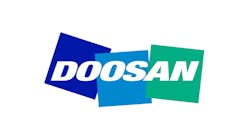Cummins Inc., the engine designer and builder, unveiled its entry for the Tier 4-compliant high-horsepower industrial engine segment: the QSK95 engine is a 95-hp, 4,000-hp product that it called “the world’s most powerful high-speed diesel.” It said that the 16-cylinder engine exceeds the power output of other large 1,800-rpm high-speed engines with 20-cylinders, but is more compact and cost-effective than much larger medium-speed engines.
The new engine will be manufactured at Cummins’ Seymour (Ind.) Engine Plant, where the company said it has invested $100 million and assigned 150 engineers to the development and production program. The QSK95 is the first entry in Cummins’ new high-horsepower, diesel and gas engine program, which will cover 12-, 16-, and 20-cylinder models. The QSK95 is pre-engineered for an additional four cylinders, to reach 5000 hp (3728 kW) of output as the QSK120 engine, from a common diesel platform.
The ductile iron block has an extended block skirt that creates structural soundness capable multiple overhauls, and an internal bedplate minimizes vibration. The unitary, forged steel pistons have been developed for durability and reuse, and all three piston rings are designed in premium materials: the top ring is plasma vapor deposition (PVD)-coated. The hardened power cylinders have midstop liners and dual piston cooling nozzles to reduce piston ring temperatures and increase wear resistance.
The gas engines will be a different design, not a derivative of the diesel engines, but those details will not be released until 2013, according to Cummins High-Horsepower vice president and general manger Mark Levett.
Levett called the new product “a landmark in the evolution of the large high-speed diesel engine, designed with the power and durability to surpass all other high-speed engines while also challenging much larger and higher capital cost medium-speed engines.”
According to Cummins, the QSK95 will meet EPA’s final Tier 4 standard and other stringent emissions standards on the basis of its own selective catalytic reduction after-treatment system to replace the exhaust muffler.
EPA’s Tier 4 standards were released in 2004 and are to be phased-in by 2015. They require manufacturers of off-road diesel engines to achieve NOx and particulate-matter (PM) emissions to be reduced by about 90% below the prior (Tier 3) standard (in place since 2000.) It indicated these emission reductions may be achieved by using control technologies —including advanced exhaust gas after-treatment — similar to those required in the 2010 standards for commercial truck (highway) diesel engines.
Cummins said its QSK95 was developed for “high-hour, high-load applications” in passenger and freight trains, marine vessels, and mine hauling trucks. It said operators will benefit from higher equipment uptime and a longer service life.
The engines also have application for power generation, for example a drilling power source on offshore oil-and-gas platforms, and the developer plans to use the QSK95 to power a new genset providing a 3.5 MW of high-speed output.
“The QSK95 moves Cummins into a significantly higher power class, and we know that many of our customers have been eagerly anticipating us making that move. During the development of the QSK95, we engaged with hundreds of potential users to ensure that we fully reflected their operational and installation needs,” Levett said.
